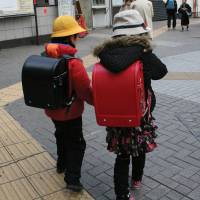Dear Alice,
As a parent of two children who negotiated the Japanese educational system from day care to university, I've always been curious about "randoseru" — those box-like leather schoolbags used by every primary school student in Japan. First-graders nearly topple over from the weight of them; by the time the kids have grown into rangy sixth-graders, the bags look like carbuncles on their backs. So where the heck does the word "randoseru" come from, and how did they get to be so ubiquitous?
Jan S., Osaka
Dear Jan,
I started my research on your questions by consulting a good dictionary, which reported that "randoseru" comes from the Dutch word "ransel." As it happens, I live with a fluent Dutch speaker, so I tried running that by him. He hemmed and hawed, checked a Dutch dictionary and finally called an elderly relative back in the Netherlands. Only then would he confirm that "ransel" is indeed a Dutch word, which describes a rucksack once used by soldiers. But no one uses that word anymore, he said.
Nitpickers may wonder how the Japanese rendering ended up with that "do" sound in the middle: Wouldn't "ranseru" be closer to the Dutch? But if you hear "ransel" the way a Dutch person pronounces it, there's a hard sound between the syllables, as evidenced by the alternative spellings I found in a Dutch dictionary from 1847: "randsel" and "rantsel." I think it's within reason that a Japanese speaker would transcribe that as "do."
But let me backtrack to backpacks, for the benefit of readers who may not know what we're talking about. Randoseru are the hard-sided leather backpacks used by virtually all schoolchildren in Japan. Families invest in one sturdy satchel when a child enters school at the age of 6, and the expectation is that the child will use it for all six years of primary school. Accordingly, randoseru are built to last and have price tags to match. Last year, the average purchase price was ¥36,600, up ¥2, 900 from the year before, which is pretty amazing in these deflationary times. In department stores, a top-of-the-line randoseru retails for almost ¥60,000 ($738 at current exchange rates).
Despite a wide range in prices, randoseru all have the same basic construction: two back-straps attached to a rigid upright rectangle divided into two main compartments — a large one for books and a smaller one for papers and assorted sundries. The compartments are covered by a long flap that closes across the top of the pack and fastens low on the front. This is referred to as the Gakushuin style, after the prestigious Tokyo school that introduced it in the 19th century.
I got in touch with the archivist at Gakushuin, who faxed me a notice posted in the student lounge on May 4, 1885, directing all students to procure a new sort of leather backpack. "Gakushuin had a strong military curriculum at the time," Kotaro Kuwao explained. "Students were encouraged to be physically active, including walking long distances to school. As far as we have been able to confirm, a few students started using backpacks on their own initiative. The school, seeing the advantages of hands-free walking, then decided it should be standard equipment." The notice uses the word "randoseru," which it describes as a military-style backpack based on European design.
Other schools followed Gakushuin's example, but randoseru remained a big-city phenomenon until after World War II. "Outside of cities, children continued to carry their books in a furoshiki cloth wrapper," Susumu Uchida of the Japan Luggage Association told me. "It was only after the war, as families became more affluent, that randoseru use became widespread."
Interestingly, randoseru were never mandated by the education ministry and public schools generally don't require them. Yet by the early 1960s, randoseru had become a "must have" item for primary school children.
Somewhere along the line — no one I consulted could say exactly when or why — a clear color line developed: red for girls and black for boys. One interesting theory I came across suggested this gender-based color preference may have been borrowed from geta, the traditional wooden clogs. Some years ago, I got help on a column from Kyoko Ichida, a curator at the Japan Footwear Museum in Hiroshima Prefecture, so I decided to give her another call. She admitted that she'd never thought about randoseru color coding, and couldn't say whether they had anything to do with footwear. But she did confirm that in the early postwar period, when randoseru were widely popularized, the preferred colors for straps on children's geta were black or navy for boys and red for girls.
Originally, randoseru were constructed of leather or pig hide, but today more than 70 percent are made from a synthetic leather called "Clarino." The main advantage of this material, which was invented in 1965 by Kuraray Co. Ltd., is that it's lighter than leather. Randoseru are heavier than the cloth and nylon backpacks used by schoolchildren in other countries, and parents pay close attention to weight when selecting which model to buy. Despite newfangled details like reflectors, hooks for personal alarms and larger models that accommodate A4 size folders, the average weight of a randoseru has dropped from 1,200 to 1,000 grams. Ultra-light models run around 800 grams.
But getting back to color, there are far more colors available now and children are more adventurous in choosing them. In 2010, the most recent year for which statistics are available, black accounted for only 60 percent of randoseru sales for boys, who also selected colors including navy, marine blue, brown and green. Girls, meanwhile, have made pink the "new red": about half of purchases for girls were in shades of pink ranging from crimson to pastel, while only 22.5 percent chose the classic red. Other colors popular with girls include light blue and caramel brown. Purple was introduced in 2010 and immediately grabbed 8 percent of the market for girls.



